Until recently, disasters were not a common occurrence and majority of pre-2000 disasters were all natural disasters. As time progressed, disasters, both natural and man-made, have become a common occurrence and it is not surprising anymore to find out that one or more of your friends and acquaintances have an Urban Survival Kit stashed somewhere in their house, fully stocked and ready to use.
[the_ad_placement id=”in-text-1-type-r”]Bug-out bags, Get home bags and survival kits are some of the terms that other survivalist use for these simple and efficient way of preparation but they all have the same objective and purpose. A good urban survival kit is a form of insurance whenever a disaster strikes a highly urbanized area and these kits will enable you to evacuate your home or refuge as quick as humanly possible. See our list of the top bug out bag backpacks for more information.
Preppers and survivalists alike have often preached the necessity of having a survival kit ready in urban areas and military personnel and even master criminals already take advantage of having such a kit at the ready when they need to “disappear” for a while.
The urban survival kit
The Urban Survival Kit is part of several preparatory steps that you can take to be better prepared when disaster strikes. The first and most important part of any survival preparation plan is, well, to have a feasible and foolproof plan.
A survival preparation plan should be simple enough that anybody can follow it and should contain all the necessary details that will help you survive any disaster. It should contain a route or a map that will detail your projected actions and alternative actions if the main route is blocked or more affected by the disaster. The survival kit’s role in the disaster preparation plan is to ensure that you will survive with minimal supplies.
Get home vs. bug out
The Get Home bag and the Bug Out bag are both survival kits and may contain the same items but they differ in their purpose and size. A Bug Out bag is your standard survival kit while the Get Home bag is a smaller version of it and it something that you can carry anywhere you go. Do read our article on the benefits of having a get home bag to get more insight.
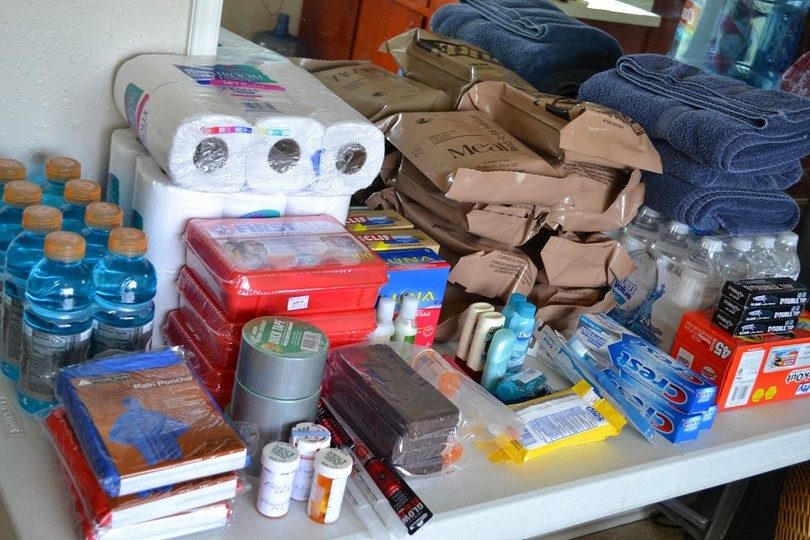
In essence, the Get Home bag is your Urban Survival Kit since you can carry it around urban areas, making it more accessible than the larger bug out bag.
Tiered system
Generally, urban survival kits follow a tiered system that is patterned after how the military packs their own survival kits. The tiered system is based on a logical analysis of projected needs for the kits in order that they will or can be needed.
- On person – as defined by its title, on person gears are those that can be stored or stashed on your person; it can be in your pockets, looped or hooked around your belt or inserted in a pouch or purse. There are usually smaller items and is not part of what you usually carry on you like your wallet, IDs or cellular phones. Preppers have given on person items the term Every Day Carry or EDC, these items will enable you to survive for a short period of time.
- Near person, on bag – these are items that can be placed in your bag. These are usually smaller and stronger versions of some of those you carry with you. You can place your gears inside a smaller bag before stashing them in your main bag so you can just take it out and leave the larger bag in case you would need to. Sometimes it’s impossible to carry your bag everywhere so the on bag gears can also be left in your car or in your work or gym locker as long as it can accessed within minutes after disaster strikes.
- Remote – these are gears that are stored on a predetermined location and are subject to debate to most survivalists since modern prepping technology has allowed for smaller, sturdier and lighter gear. Remote gears aim to help you survive and build a new life in a new location.
Choosing your gear
Understanding your immediate needs during an emergency is important in choosing what you need to put it in your urban survival kit. A good urban survival kit should be able to sustain you for 72 hours given limited, even scarce, resources.
Factors to consider
Like most essential lists, there are factors to consider when building your own urban survival kit.
Medical condition – it is very important to consider your health and know which medicines you need to bring with you for an extended period of time. This may include aspirins, Paracetamol, some antibiotics and antihistamines. This should also include any maintenance medicines that you may be taking.
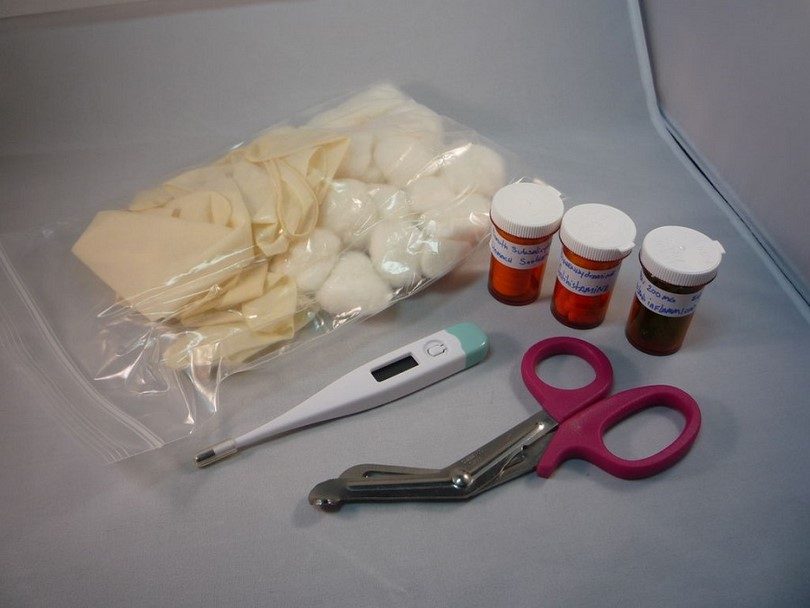
General location – while preparing your survival plan, it is always good to take a look at your general area and identify risk areas and plan a route that will move you away from them. If your route will fall along a forest or a wooded area, you may want to bring along some gears that will help you pass through that area.
Debris – now, it is hard to anticipate which part of your surroundings will become debris after a disaster but it may be good to consider that you will need a tool or two that will help you smash or cut through them.
[the_ad_placement id=”in-text-2-type-r”]Access – this may be access to another area or location but this can also mean access to food, water, medicines and other necessary supplies if in case your own runs out, especially if search and rescue facilities are also down.
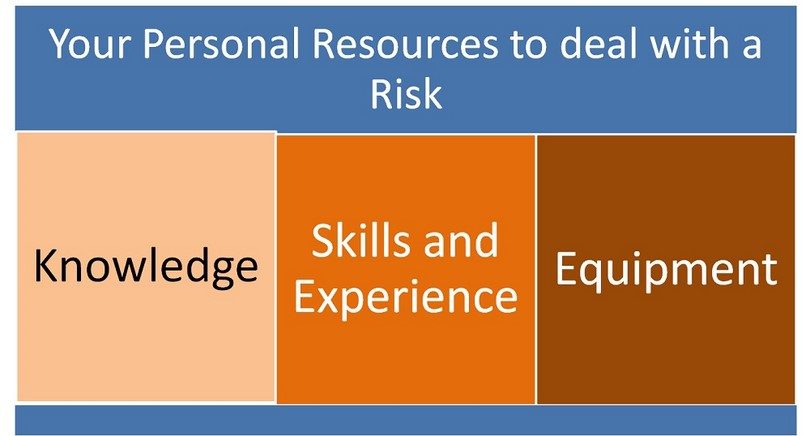
Risk assessment – risk planning is part of any survival plan and identifying possible risks is tantamount to survival. Looting, vandalism, theft and sanitation should be taken into consideration when planning your evacuation routes.
Packing it in
A good urban survival kit should be easy to carry and a back pack is the most recommended bag for stashing your get home gears. Messenger bags will do fine as well but you run the risk of having the straps get caught on something sharp or something protruding out of a wall or floor.
Whatever you choose your bag to be, it has to be made of strong materials and the stitching should be able to withstand great pressure and should not unravel easily.
List of essentials
Based on the factors provided, here is a list of items that you may want to consider placing in your urban survival kit.
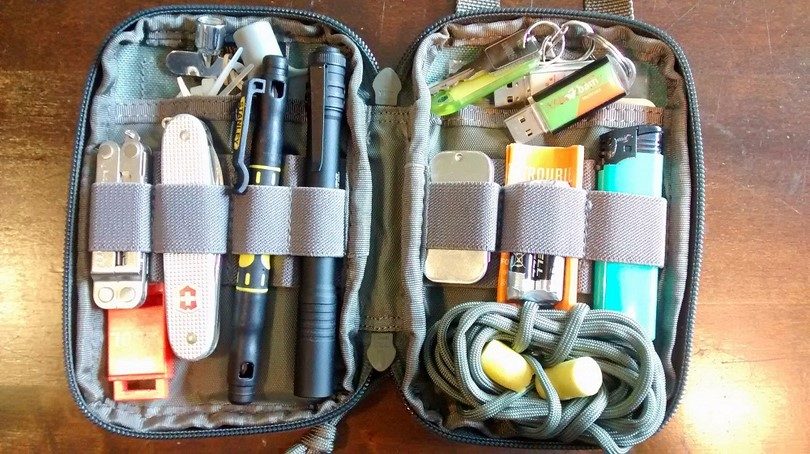
These are suggestions, you may add or subtract items as you see fit.
Every day gear (On-person)
- Multi-tool – most multi-tool kits come in the form of pliers with several appendages that fold right into the handles. These appendages include a small saw, a utility knife, screw drivers, scissors, a can opener and a wire cutter. These tools can be used in a variety of ways in emergency situations and the multi-tool can come in handy even in non-emergency situations.
Take note that some buildings and transport hubs do not allow knives and multi-tools in, especially if it is non-essential to your trip. It may be wise to leave it in such instances or hide it very, very, very carefully to avoid detection. - Flashlights – disasters can cut off power for a long period of time and it is always important to see what you’re doing and where you’re going. You can bring large flashlights for better visibility but since a get home bag should be lightweight and easy to carry, you should consider purchasing or bringing along LED lights that are compact and bright enough. LED lights also consume less power and will not need replacement for a good number of years.
- Parachute cord bracelets – paracord bracelets are a great addition to any urban survival kit and can form part of your on-person gear set. Parachute cord bracelets not only provide you with a sturdy length of parachute grade levels, some designs include either a flint or a small knife that is inserted into the thread. A good survival kit would one or two parachute cord bracelets into the arsenal of tools. See also our DIY paracord survival belt to complete your gear.
- Spork –the amalgamation of spoon and a spork. Sporks come in handy when it comes to meal time especially if you need to stir and, well, eat. Some sporks come with a foldable can opener or a foldable knife. Chop sticks are also a good option as they can function both as a spoon and as a fork as well as a hair ornament and can also be sharpened and used as stakes for traps and cooking implements.
- Whistle – another great gear on this list, whistles can not only act as a form of entertainment but will also act as a tool for communicating with authorities, especially if you are trapped in an enclosed space or if you are lost in the wilderness.
- Fire kit – fires is one of the important elements in life and creating it should be part of your skill set. Lighters and flint act as your fire starters and pieces of paper or wood chips can further stoke the flames and keep it going.
- Essential medicines – this should be separate from your first aid kit and can contain just the medicines that you will need immediately. These can be placed in your coin purse or wallet for easier access.
- Tickler pad and pencil – a small notebook and small pencil can come in handy for taking down survivor names, street names, landmarks and other notable details that will help you or the authorities during disaster recovery.
Get home bag (near person, on bag)
- Extra clothing – depending on the season, you may want to include a change of clothes in your get home bag. Choose clothes that are lightweight and can be folded or compressed into a smaller size although winter clothes may be harder to fold and will probably be heavier. A typical survival clothing kit would include a shirt, a couple of underwear, a couple of socks and a pair of pants with sizeable pockets for storing on person gears.
- Weather proofing – we can never tell when disaster will strike and we can never tell what kind of disaster it will be. It is always a good idea to have some weather proofing gear included in your survival kit. This may be in the form of an umbrella or a wind breaker or a winter jacket. Preppers, to avoid having to repack, would often replace winter-specific clothing with a thermal or space blanket.
Mountaineers often place their gears inside a large water-proof plastic bag before placing it in their mountain packs; you can also apply this to your urban survival kit to make sure that your survival kit is dry. - First aid kit – the basic first aid kit would contain antibacterial ointments, band aids, disinfectant, gauze pads, gauze tape and emergency medicines like antihistamines, analgesics, antibiotics, anti-diarrhea and oral rehydration tablets.
As previously mentioned, also put in your specific medications. Some other things to put in are a triangular bandage, or a bandana, some pieces of wood for splints and a scalpel or another knife to be used for medicinal purposes only. Some would include a thermometer and a pair of extra scissors as well. - Duct tape – the quintessential tool, duct tape has proven itself to be handy and can be used for whatever reason you can think of. You can repair your shoe with it, bind a splint with it (it may hurt later), patch up any tear in your bag or clothes, and so on. Choose a brand that is known for its quality and is the best for your money, cheaper brands can break easily and further endanger you if not used properly.
- Extra cellular phone – it is undeniable that mobile phones become a great tool during an emergency but we shouldn’t rely on just one unit, it is advisable to keep a fully charged back-up phone in your bag. It should come with its own SIM card and should be kept powered off to avoid battery drain. Make sure to check on it every week or so to check for the battery levels and charge it as needed.
- Knife – you can pack in a standard kitchen knife or better yet, pack in a good sized utility knife. Some designs have additional tools molded into their forms like bottle openers and saws. A good knife remains sharp for a long period of time and the best utility knives are often foldable and not easy to detect. Some EDC companies offer a knife that comes in the size and form of an ATM card for easy on-person storage.
- External battery pack – having a durable power bank can get you out of tight spots especially during extended periods of power loss. Battery life of both the power bank and your gadgets can also be extended if you try to use them only for essential tasks.
- Food and water – the most essential of the essentials. Urban survival kits should contain provisions that will last you for 72 hours and should be easy to prepare and eat. You have to remember that conditions might not allow you to cook your food so make sure to pack only those that are ready to eat and will not spoil easily like crackers and nuts. Trail mix can also be added for its nutritional value.
Weaponized bug-out bag
Some preppers would argue that handgun is a very important addition to any get home bag as this would serve as protection from those that mean use harm and can most definitely be used to hunt animals for food and scare the bigger ones away. Other preppers sometimes include a machete and other deadly weapons in their urban survival kits just in case.
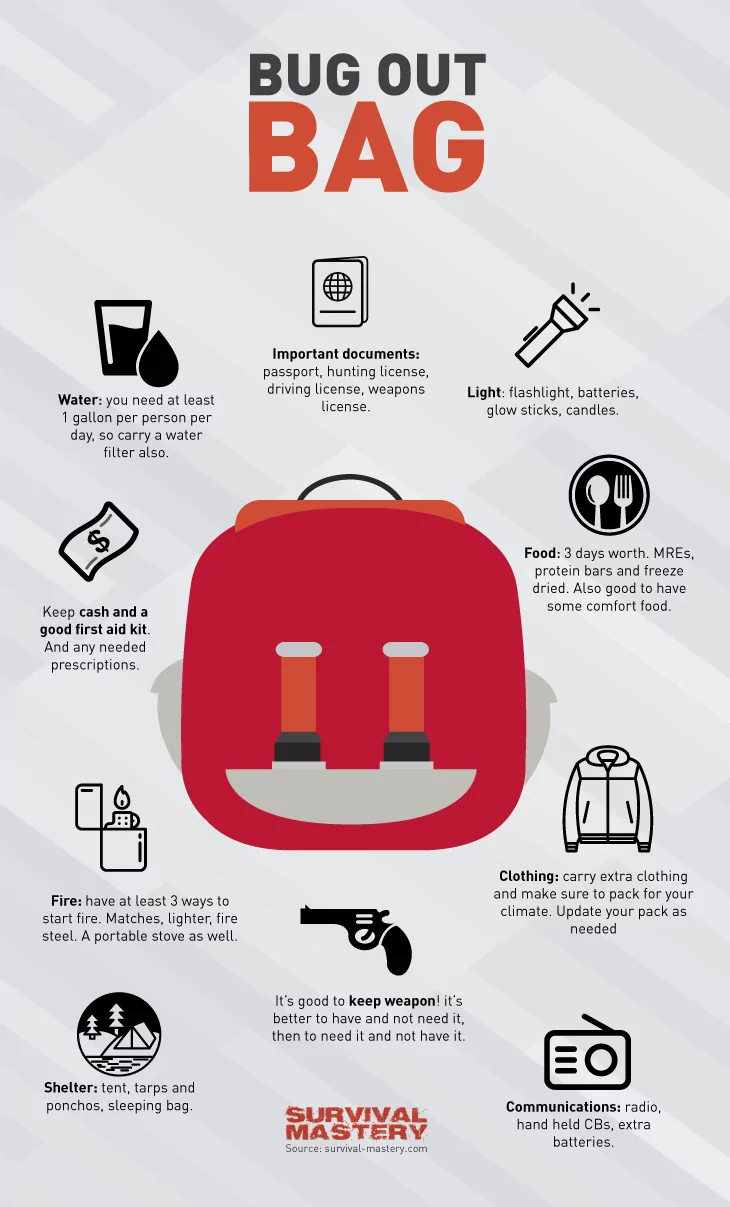
Having an urban survival kit prepares you for any kind of disaster but we also need to know that sometimes, it is better to stay in until help arrives than go out and join other people who will be walking about doing the same thing.
See also: Survival Pistol: Important Things You Need To Know
Of course, this is dependent on your situation right after the disaster, if you are in a building that is about to collapse then you have to get out by all means but if you’re safe enough where you are then stay put until recovery commences.
[the_ad_placement id=”in-text-3-type-r”]Survival kits will vary and as technology improves so should our get home bags. We can choose to upgrade our gears as we fit and store those we replaced to serve as back-ups. Some survivalists have amassed great vaults of gear and have installed bunkers to store them too.
Mankind sees survival as his main goal in life and his study of history and science has enabled him to be more prepared for disasters. The Urban Survival Kit is one of the ways for him to show that he is ready and that he will live in the end.




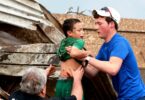

I carry a 25-litre backpack at all times and it has the basic equipment that I would need as well as my laptop and its accessories. The bag itself is waterproof but I do have an extra raincover as well as a Gore-Tex jacket as added protection. It has become a comfort blanket of sorts and I don’t feel complete without it. You can just imagine what’s going through my head during formal functions (but it’s always in the car nevertheless).
Thank you for sharing this with us Kevin. Your choice sounds quite interesting!
A reasonably-stashed panic room is the most relieving preparation for me but I do have an EDC for each of my family in case we must evacuate our home. But I haven’t thought about stashing our car. Hmmm, can I only pack disaster food packs then? Other food probably cannot withstand the heat inside the trunk.
The most important thing that you should always remember to do when stashing an urban survival kit is following through your list of essentials.
Based on the risk assessment infographic, do you think it’s still important to pack things you do not know how to use but you think might be useful along the way? There is some debate about this since carrying something you do not know how to administer or should be used above a level you have been trained for creates more harm than help.
“Based on the risk assessment infographic, do you think it’s still important to pack things you do not know how to use but you think might be useful along the way? ”
You might run into an ally who knows how to use them. Or you may not need them and someone else does, providing a barter opportunity.
It is always good to equip yourself with all the necessary survival essentials. However, what you backpack does entirely depend on the event. It is always advisable to backpack what you can use.
It is always wise to carry a gear that you can use. For instance, you cannot carry a weapon that you do not know how to use. However, this is an arguable topic.
Survival kits seem to be the basic preparatory measures against natural and man-made disasters that occur frequently. There is the need to prepare ahead of time in order to escape successfully. Survivalists and preppers have devised strategies to prepare their kits in order to handle these emergencies. There is a knife, first aid box, extra battery, extra cellular phone, food, water, etc. in a survival kit. What are your own preparations and strategies to stay safe in emergency situations?
A BOB is the most important thing when preparing for any disaster, either natural or man-driven. Most people associate a BOB with preppers and survivalists, but the truth is that it is the essential gear for everyone.